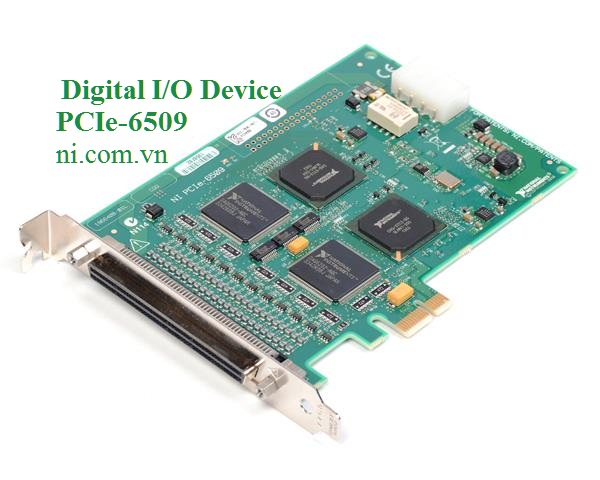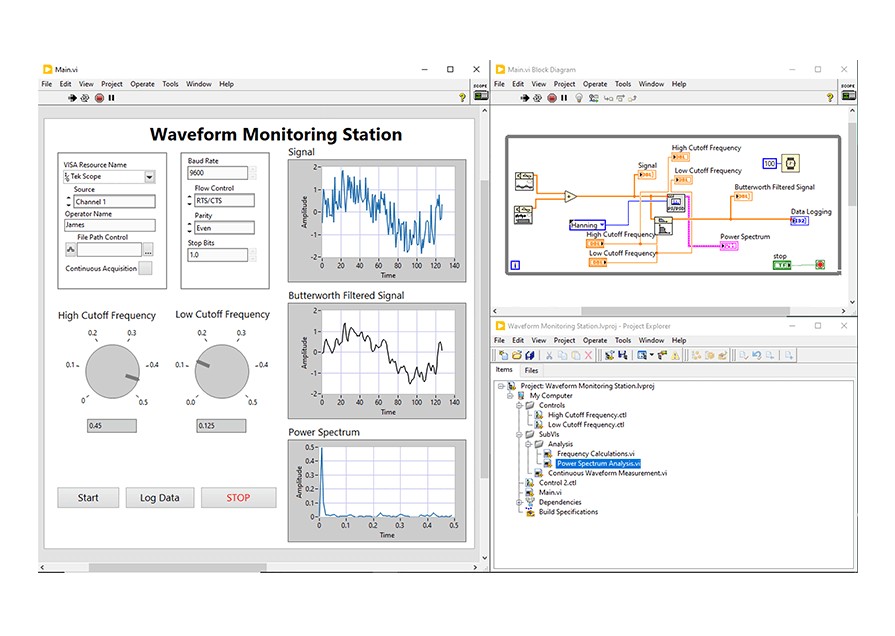

The development of automation in particular and engineering technology in general today is increasingly associated with the achievements of software technology. If in the past, the implementation and simulation of systems were difficult and complicated through programming in simple languages, today, there are more and more tools that allow engineers to quickly build in increasingly short time, with less effort and complexity, to build system models and implement complex control problems.
What is NI LabVIEW?
The LabVIEW dashboard, block diagram, and project window with code appear on the desktop screen.
LabVIEW is a graphical programming environment that provides unique productivity accelerators for test system development, such as a visual approach to programming, connectivity to any device, and a fully integrated user interface.

LabVIEW is one of the super tools
LabVIEW- stands for Laboratory Virtual Iinstrumentation Engineering Workbench, is a development environment and platform for the Visual Programming Language (VLP) built by National Instruments.
Graphical programming languages allow programmers to build programs visually using charts and diagrams instead of typing code. The development of this type of language is probably associated with the increasingly deep penetration of information technology into engineering and application industries, in which users do not need to spend too much effort on programming to be able to build the system, instead can focus on the application of the program.
One of those languages is Graphical programming Language, abbreviated as G, which was first developed by Apple Macintosh, and used by National Instruments (NI) to build the famous LabVIEW software toolkit.

NI LabVIEW is a graphical programming environment that provides unique productivity accelerators for test system development, such as a visual approach to programming, connectivity to any device, and a fully integrated user interface.
The LabVIEW programming environment simplifies hardware integration for engineering applications so you have a consistent way to collect data from NI and third-party hardware. LabVIEW reduces programming complexity so you can focus on your unique engineering problem. LabVIEW allows you to visualize results instantly with a built-in drag-and-drop engineering user interface and integrated data viewer. To turn captured data into real-world business results, you can develop algorithms for advanced data analysis and control with the included math and signal processing IP or reuse your own libraries from a variety of tools. To ensure compatibility with other engineering tools, LabVIEW can interoperate with and reuse libraries from other open source software and languages.
LabVIEW is mainly used in data acquisition and processing, device control, and device automation. It can run on many operating systems, from Mac, Windows, Linux and some other embedded operating systems.
As mentioned, the first and most famous function of LabVIEW is data acquisition (Data Acquision or DAQ). NI supports a wide range of DAQ hardware in terms of quality, size, and price, serving a large number of applications from simple to complex. And if you do not want to spend money to buy those devices, you can still build your own hardware and communicate with the computer via USB, LPT, COM, PCI, Bluetooth, Ethernet, Wireless ports...LabVIEW has a set of libraries that allow you to work well with those ports. (if you are good enough).
You can also do a small project of collecting and processing sound, with only LabVIEW 7.1, a computer microphone, using the Sound Signal Acquision tool. And there are many other applications, such as collecting and processing images, vibration, temperature...
Besides supporting data acquisition, LabVIEW provides a very rich library supporting signal processing. Many people say that Malalb is stronger than LabVIEW in this point, but I have never seriously thought about it. (Not a signal processing specialist, I dare not comment on it)
But there is one advantage that I think Matlab cannot have, which is that the G programming language has a mechanism that allows designers to manage the execution time of loops and commands relatively tightly, while also managing resources and executing parallel loops (multi-thread), so LabVIEW programs can meet time requirements very well, even real-time requirements.
Another prominent application of LabVIEW is device control and industrial equipment automation. Because of its multi-threaded processing capabilities and tight execution time management, LabVIEW becomes a great tool for computer-based control applications. NI provides a wide range of acquisition, processing and control cards that allow the construction of a computer-attached control system that both performs effective control operations and takes advantage of the excellent processing capabilities of personal computers. The hardware devices (hardware targets) provided by NI include: NI motion (motion control cards), industrial PCI cards, PXI, programmable controllers PAC, fieldpoint, compactRIO... It can be said that National Instruments has built an entire device empire from a simple to a great programming language.
Nowadays, besides the traditional directions, it seems that NI wants to focus on the FPGA field. With this development direction, LabVIEW will really stand out with its famous parallel and multi-threaded processing capabilities. With the emergence of a series of programmable input/output devices (Reconfigurable Input/output), designers can freely change, configure, and execute processing cores and parallel loops to perform complex processing/control problems that require the most stringent time requirements.
Features and Applications of LabVIEW
LabVIEW has what you need to build automated test systems, fast. Outpace the competition with LabVIEW. Unlike other solutions:
LabVIEW can connect to any device, regardless of vendor.
LabVIEW has a native user interface for monitoring and controlling experiments.
LabVIEW has thousands of technical analysis functions.
LabVIEW works with popular languages, such as Python, C, and .NET
reference: www.ni.com.vn